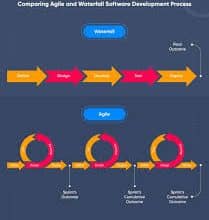Companies use resource planning strategies to guarantee that their resources are used efficiently for each project. Manufacturing resource planning (MRP II) is used to control processes in the manufacturing industry. In other words, understanding MRP II and other systems may assist you in determining the optimal strategy for your firm. So, in this article, we will answer the question, “What is manufacturing resource planning?” as well as examine its significance, compare it to materials requirement planning (MRP I) and enterprise resource planning (ERP), and go over the processes in MRP.
What Exactly is Manufacturing Resource Planning (MRP II)?
Manufacturing resource planning (MRP) is a system for successfully planning the utilization of a manufacturer’s resources. It helps producers create a precise production schedule for the future that optimizes costs while making the most use of the resources at their disposal.
Sales forecasting assists a producer in estimating the expected demand for a product so that the appropriate amount of raw materials can be sourced and deliveries and quantities can be scheduled on time. It also specifies a goal production level, calculating the number of machine units and manpower hours necessary during a specific production cycle.
Manufacturing resource planning determines the best order amount and frequency for raw materials by combining the typical use for a projected replenishment lead time with the required safety stock to prevent stock-outs.
Understanding Manufacturing Resource Planning (MRP II)
Manufacturing resource planning (MRP) is a computer-based system that can generate precise production schedules based on real-time data to synchronize component material delivery with machine and manpower availability.
A material needs planning information system is a sales forecast-based system that schedules raw material deliveries and quantities based on assumptions about the machine and labour units needed to meet a sales forecast.
By the 1980s, manufacturers realized they required software to communicate with their accounting systems and forecast inventory needs. MRP II was available as a solution, incorporating this functionality and all of MRP I’s capabilities.
Examples of Manufacturing Resource Planning (MRP II) Software
The following are a few examples of popular MRP software providers:
- IQMS
- Fishbowl
- FactoryEdge
- Prodsmart
- abas
- Oracle Netsuite Manufacturing Edition
- Epicor
- S2K Enterprise
MRP versus MRP II
MRP II has replaced MRP I software. The majority of MRP II systems provide all of the features of an MRP system. MRP II, on the other hand, adds capability in logistics, marketing, and general finance in addition to master production scheduling, bill of materials (BOM), and inventory tracking.
MRP II, for example, can account for aspects that MRP cannot, such as machine and staff capacity, resulting in a more realistic and holistic picture of a company’s operating capacities. Many Manufacturing resource planning (MRP) solutions also have simulation functions that allow users to add variables and view the results. Manufacturing resource planning (MRP) is sometimes called a closed-loop system because of its capacity to provide feedback on a given process.
MRP I would include the three major functionalities described below:
- A material bill
- Master production planning
- Inventories piled up
An MRP II would include the three properties mentioned above, as well as the four listed below:
- Machine capacity planning
- General accounting systems
- Assurance of quality
- Demand Forecasting
What Steps are Involved in MRP II?
MRP II is a valuable tool for manufacturers. It entails planning, scheduling, and quality control. It is a system that gives information to an organization’s decision-makers to assist them in making effective business decisions. In manufacturing resource planning (MRP), you can take the following steps:
#1. Determine the Product’s Demand
Begin by acquiring information on client purchase habits and shopping behaviours. From there, you might try to determine the materials required for production to meet demand. The BOM lists the raw materials, assembly, and other items the manufacturer requires to make the product. It also provides an estimate of the human resource requirements for the production.
#2. Contrast the Product’s Current Inventory with the Demand
This stage compares the product’s demand to raw materials and finished goods inventory. This might help you assess whether to place a material order or produce more things to meet demand. When determining demand, it is critical to consider current sales, seasonal volatility, and the product’s shelf life. Resource planning assists you in allocating the necessary resources to the work. These can be physical items like machines or raw supplies. They can also be humans, such as salespeople or production crew members.
#3. Make a Timetable
Creating a schedule that organises the necessary tasks to meet the demand is critical. This involves ordering supplies, manufacturing, and paying suppliers and utility companies. You should also offer a deadline to ensure that the schedule is feasible. You can also include any additional remarks or recommendations to ensure the team and the company understand the strategy.
#4. Keep an Eye on the Production
You can evaluate if the production team is fulfilling milestones by monitoring the entire process. This also allows you to keep track of your cash and guarantee that the production stays within the budget. MRP II software frequently informs you if production is not meeting requirements or resources are running low. You may also wish to utilize SCM to monitor the supply chain and ensure that products are delivered on time.
#5. Go Over Everything Again and Make Any Required Changes
It is critical to go over the plan and make changes as needed. This enables you to account for any unanticipated events, such as labor issues or a spike in demand. It also guarantees that the production schedule fulfils the objectives of the organisation.
What Exactly is Enterprise Resource Planning (ERP)
MRP II was based on previous materials requirement planning systems. It is slightly more advanced than MRP I in that, unlike MRP I, it includes extra data about employee demands and other financial needs of the organisation. MRP I and MRP II, when combined, gave rise to the Enterprise Resource Planning (ERP) system.
ERP allows a manufacturer to combine data from all critical areas of its business processes. Planning, raw material purchasing, inventory management, sales, finance, marketing, human resources, and other functions may be included in the ERP system.
Although MRP II systems are still extensively used, ERP software is thought to be more sophisticated. This is because ERP allows operators to include data outside the purview of industrial operations. The system may integrate asset and customer relationship management, both critical for service-based businesses.
How to Achieve Manufacturing Resource Planning
When developing a manufacturing resource strategy, you must consider three questions: what is required? How much is required? And when is it required? Working backwards from the end product, you can assemble the materials needed for a manufacturing resource plan.
Manufacturing resource plans can be broken down into four fundamental steps:
#1. Make estimations of your product’s Demand
You may determine the resources required to meet that demand. A bill of materials, a list of raw materials, assembly, and other components required to make your finished product, divides those resources. Remember to include your people in this estimation.
#2. Resources Contrast Demand with Present Inventory
This will tell you how many resources you’ll need to meet demand in addition to what you already have on hand. Manufacturing resource planning directs inventory to where it is needed.
#3. Create a Production Schedule
This entails determining how long each step of your manufacturing process will take. You work backwards from a deadline once more.
#4. Keep an Eye on the Entire Procedure
Check that you are meeting milestones and not exceeding your budget. Most manufacturing resource planning software will send you notifications if something goes wrong. Prepare a backup plan in case this happens.
What is the Role of Manufacturing Resource Planning?
Manufacturing resource planning refers to an information system utilised by businesses that manufacture items. The integrated information system improves management decision-making by centralising, integrating, and processing manufacturing-related information.
What are the Components of Manufacturing Resource Planning?
- A comprehensive production timetable.
- Technical information.
- Materials list.
- Data about production resources.
- Orders and inventories.
- Purchasing administration.
- Planning for material requirements.
- Control of the shop floor.
What is MRP & ERP in Manufacturing?
MRPs (Material Requirements Planning) are a wonderful tool for manufacturers to manage their shops because they incorporate inventory, capacity planning, and scheduling elements. ERPs (Enterprise Resource Planning) are a better approach for manufacturers to get control of their operations.
What is MRP in Supply Chain Management?
Material requirements planning (MRP) determines the materials and components required to produce a product. It comprises three major steps: inventorying the resources and components, determining which extra ones are required, and arranging their manufacture or acquisition.
What are the Benefits of MRP?
- Reducing production time and avoiding delays.
- Getting rid of human error.
- Ensure customer happiness.
- Improving cross-functional collaboration and communication
- Managing material and product inventory.
- Conserving resources…
- Select the best software solution system.
Conclusion
Manufacturing resource planning (MRP) is useful for any manufacturing organisation. It helps with business operations, production planning, and inventory management. It not only delivers real-time data, but it also provides great planning and asset management.
Other benefits of a competent Manufacturing resource planning (MRP) software system include the capacity to shorten production times and help with average cost savings. As well as ensuring that your inventory level remains within acceptable constraints. You can also save time, money, and personnel by minimising time-consuming manual activities and automating procedures.
- THE WORLD’S MOST EXPENSIVE CAMERAS 2023 (Updated)
- What Kind of iPhone Do I Have: Easy Steps to Find Out
- How to Schedule an Email in Gmail, Effectively (Updated)
- MUSIC PRODUCTION LAPTOP: Best Laptops For Music Production 2023
- Production Scheduler: Job Description, Salary & Becoming One






